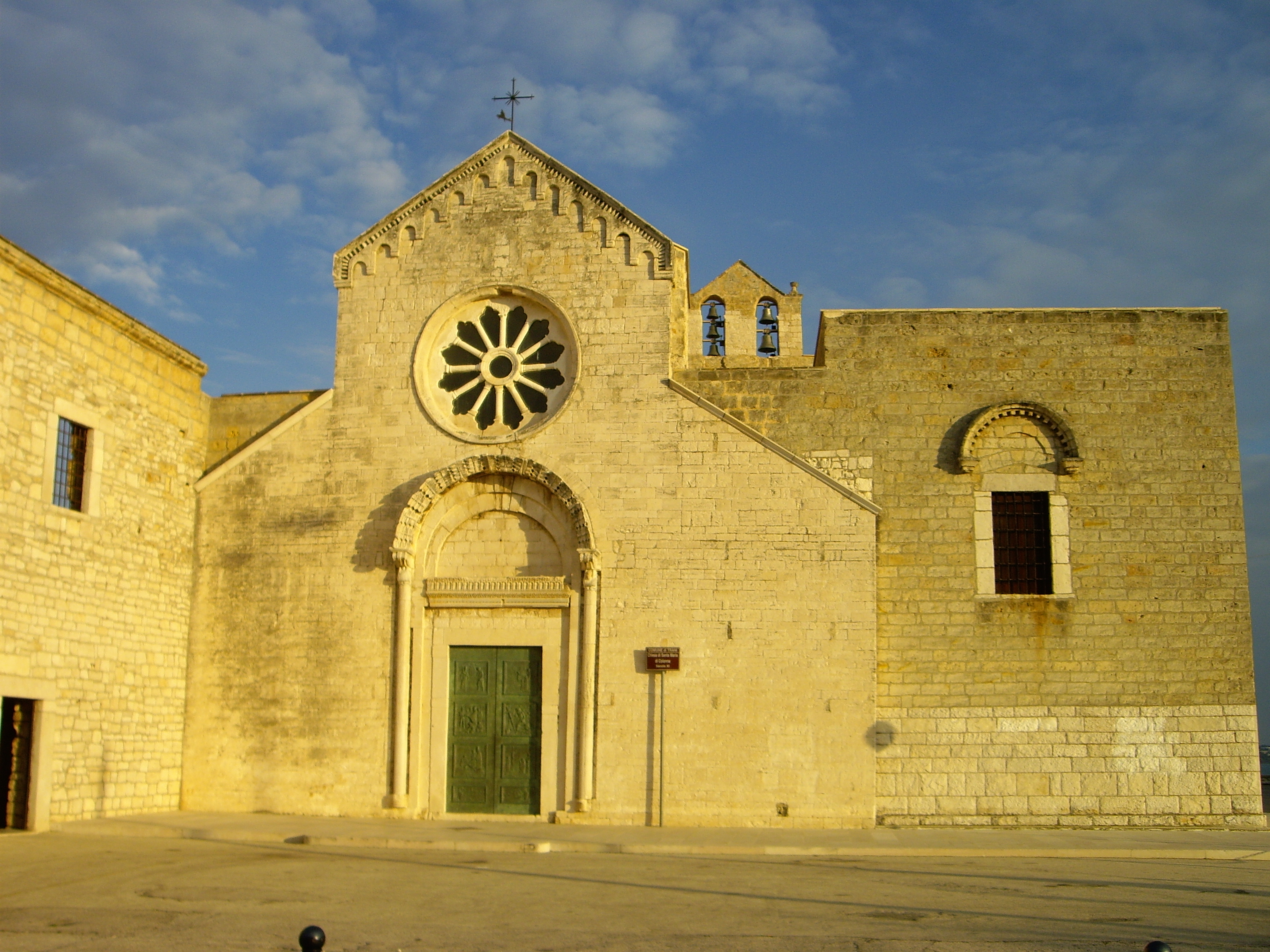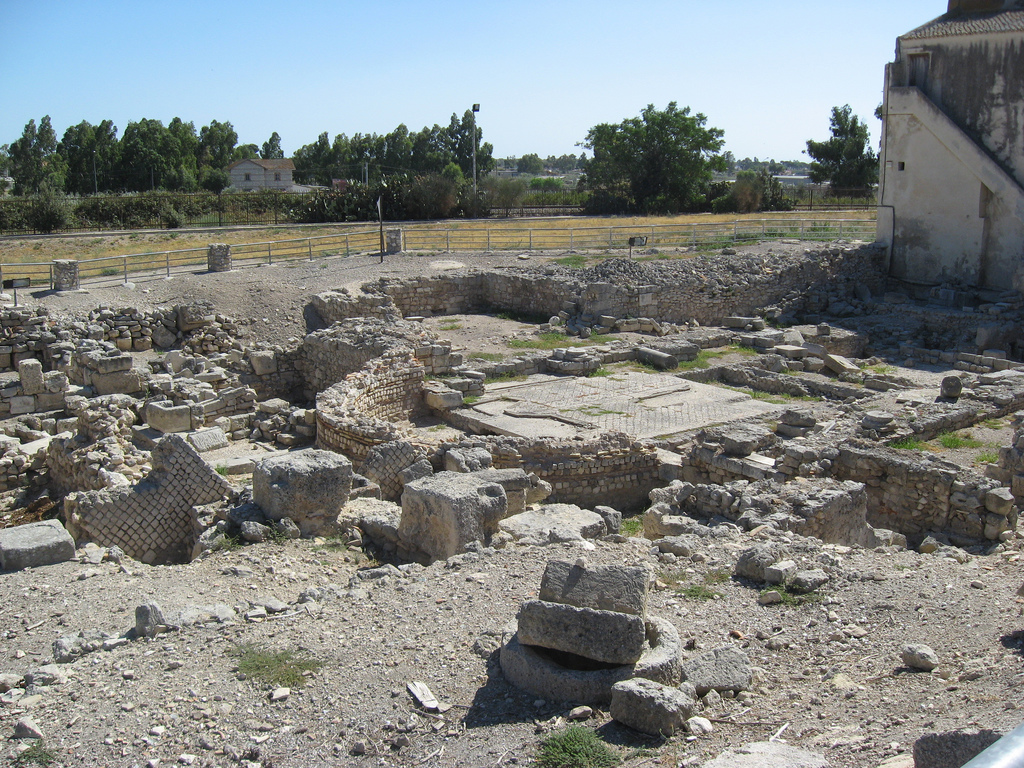|
Peter I Of Trani
Peter I (born before 1020), also known as Petronius (french: Pierron and it, Petrone or ), was the first Norman count of Trani. He was one of the most prominent of the twelve leaders of the Norman mercenaries serving Guaimar IV of Salerno. Though it had not yet been conquered from the Byzantine Empire, Peter received Trani in the Normans' division of Apulia made at Melfi in 1042. In that same division his brother Walter received Civitate. Peter probably arrived in southern Italy around 1035. It is unknown if Peter was in fact from Normandy; he may have been a Breton or a Frenchman. His father, Amicus (Amico), may have been a relative of the Hautevilles or married to one. In 1038 Peter participated in the Byzantine campaign led by George Maniakes against the Emirate of Sicily. In battle he was usually found beside William Iron Arm, the leader and first count of the Normans of Melfi. After the division of 1042 Peter fortified the region around Trani, building new cities at Andria a ... [...More Info...] [...Related Items...] OR: [Wikipedia] [Google] [Baidu] |
Normans
The Normans (Norman language, Norman: ''Normaunds''; french: Normands; la, Nortmanni/Normanni) were a population arising in the medieval Duchy of Normandy from the intermingling between Norsemen, Norse Viking settlers and indigenous West Francia, West Franks and Gallo-Roman culture, Gallo-Romans. The term is also used to denote emigrants from the duchy who conquered other territories such as England and Sicily. The Norse settlements in West Francia followed a series of raids on the French northern coast mainly from Denmark, although some also sailed from Norway and Sweden. These settlements were finally legitimized when Rollo, a Scandinavian Viking leader, agreed to swear fealty to Charles the Simple, King Charles III of West Francia following the Siege of Chartres (911), siege of Chartres in 911. The intermingling in Normandy produced an Ethnic group, ethnic and cultural "Norman" identity in the first half of the 10th century, an identity which continued to evolve over the ce ... [...More Info...] [...Related Items...] OR: [Wikipedia] [Google] [Baidu] |
Bisceglie
Bisceglie (; nap, label= Biscegliese, Vescégghie) is a city and municipality of 55,251 inhabitants in the province of Barletta-Andria-Trani, in the Apulia region (''Italian'': ''Puglia''), in southern Italy. The municipality has the fourth highest population in the province"dati del bilancio demografico ufficiale ISTAT" Retrieved 11 September 2014 and fourteenth highest in the region. Retrieved 9 November 2011 The area has been inhabited since prehistoric times, with at least two caves showing evidence of occupation during the Neolithic. Its name probably derives from the Latin "vigilae", "watchtowers", suggesting the importance of its location on the |
Geoffrey Of Taranto
Geoffrey, Godfrey, or Goffredo (died 1068x1072), called Lofredus in Latin, was an Italo-Norman military leader and the first Count of Taranto. He was the second son of Peter I of Trani, though of his elder brother, Amicus, nothing is known. He succeeded his father in the territory of Trani and was in control of it in 1064, though the city itself remained with the Byzantine Empire. His younger brother, Peter II, took the city from the Byzantines in 1054 and, taking advantage of Geoffrey's absence, took control of the patrimony. Geoffrey married a daughter of Drogo, lord of Mottola and Castellaneta. When Count Drogo of Apulia was assassinated in 1051, Geoffrey was put in charge of his young son, Richard. Geoffrey founded, probably on the site of an existing hermitage, the monastery of Santa Maria di Colonna, populating it with Cassinese monks and building it a defensive tower that still stands. In May 1063 Geoffrey conquered Taranto, which he eventually made his chief city. H ... [...More Info...] [...Related Items...] OR: [Wikipedia] [Google] [Baidu] |
Cisterna
A cisterna (plural cisternae) is a flattened membrane vesicle found in the endoplasmic reticulum and Golgi apparatus. Cisternae are an integral part of the packaging and modification processes of proteins occurring in the Golgi. Function Proteins begin on the cis side of the Golgi (the side facing the ER) and exit on the trans side (the side facing the plasma membrane). Throughout their journey in the cisterna, the proteins are packaged and are modified for transport throughout the cell. The number of cisterna in the Golgi stack is dependent on the organism and cell type. The structure, composition, and function of each of the cisternae may be different inside the Golgi stack. These different variations of Golgi cisternae are categorized into 3 groups; cis Golgi network, medial, and trans Golgi network. The cis Golgi network is the first step in the cisternal structure of a protein being packaged, while the trans Golgi network is the last step in the cisternal structure when the ... [...More Info...] [...Related Items...] OR: [Wikipedia] [Google] [Baidu] |
Robert Guiscard
Robert Guiscard (; Modern ; – 17 July 1085) was a Norman adventurer remembered for the conquest of southern Italy and Sicily. Robert was born into the Hauteville family in Normandy, went on to become count and then duke of Apulia and Calabria (1057–1059), Duke of Sicily (1059–1085), and briefly prince of Benevento (1078–1081) before returning the title to the papacy. His sobriquet, in contemporary Latin and Old French , is often rendered "the Resourceful", "the Cunning", "the Wily", "the Fox", or "the Weasel". In Italian sources he is often Roberto II Guiscardo or Roberto d'Altavilla (from Robert de Hauteville), while medieval Arabic sources call him simply ''Abārt al-dūqa'' (Duke Robert). Background From 999 to 1042 the Normans in Italy, coming first as pilgrims, were mainly mercenaries serving at various times the Byzantines and a number of Lombard nobles. The first of the independent Norman lords was Rainulf Drengot who established himself in the fortress of ... [...More Info...] [...Related Items...] OR: [Wikipedia] [Google] [Baidu] |
Amatus Of Montecassino
Amatus of Montecassino ( la, Amatus Casinensis), (11th century) was a Benedictine monk of the Abbey of Montecassino who is best known for his historical chronicles of his era. His ''History of the Normans'' (which has survived only in its medieval French translation, ''L'Ystoire de li Normant''), is one of three principle primary sources for the Norman Conquest of southern Italy--the other two being the histories of William of Apulia and Geoffrey Malaterra. Amatus describes the Normans from the perspective of his abbey, one of the most important religious and cultural centers in Italy at the time. His history is the earliest extant account of the Norman sieges of Bari and Salerno, their conquest of Sicily, and the careers of both Robert Guiscard and Richard Drengot, as well as the Gregorian Reforms seen from the papal point of view. Background Nothing is known for certain about Amatus before he became a monk. Possibly having been born in Salerno, Graham Loud suggests that he m ... [...More Info...] [...Related Items...] OR: [Wikipedia] [Google] [Baidu] |
Anonymus Barensis
''Anonymi Barensis Chronicon'' is a medieval Italian annalistic chronicle. Composed in Latin by an anonymous author from Bari in the first quarter of the 12th century, it covers the years 855–1118, concentrating first and foremost on the events in Bari and Apulia. The First Crusade is followed in some detail, however, as are the Byzantine affairs. ''Anonymi Barensis Chronicon'' has much content in common with two other Bariot chronicles, ''Annales Barenses'' and, especially, '' Annales Lupi Protospatharii'' (with which it also shares the beginning). Therefore, all three are assumed to be based on some older chronicle that no longer survives. The ''Chronicon'' becomes more detailed from the 1040s on, also diverging in coverage from the other chronicles. No medieval copy of ''Anonymi Barensis Chronicon'' is known. The survival of the chronicle is due to the 17th-century Italian historian Camillo Pellegrino who transcribed the text from a manuscript in Salerno and published it in ... [...More Info...] [...Related Items...] OR: [Wikipedia] [Google] [Baidu] |
Siponto
Siponto ( la, Sipontum, grc-gre, Σιπιούς) was an ancient port town and bishopric in Apulia, southern Italy. The town was abandoned after earthquakes in the 13th century; today the area is administered as a ''frazione'' of the ''comune'' of Manfredonia, in the province of Foggia. Siponto is located around 3 km south of Manfredonia. History According to legend, Sipontum was founded by Diomedes, product of the union of the Homeric hero of the same name with the daughter of the king of the Daunians. Siponto was probably founded by the Daunians. Sipontum was a flourishing Greek colony, its Greek name being Sipious (Σιπιούς); having fallen into the hands of the Samnites, it was retaken about 335 BC by King Alexander of Epirus, uncle of Alexander the Great. In 189 BC it became a Roman colony with its original Sipious name still used in Byzantine times, and in 663 AD it was taken and destroyed by the Slavs. In the ninth century, Sipontum was for a time in the pow ... [...More Info...] [...Related Items...] OR: [Wikipedia] [Google] [Baidu] |
Duel
A duel is an arranged engagement in combat between two people, with matched weapons, in accordance with agreed-upon Code duello, rules. During the 17th and 18th centuries (and earlier), duels were mostly single combats fought with swords (the rapier and later the small sword), but beginning in the late 18th century in England, duels were more commonly fought using pistols. Fencing and shooting continued to co-exist throughout the 19th century. The duel was based on a Code of conduct, code of honor. Duels were fought not so much to kill the opponent as to gain "satisfaction", that is, to restore one's honor by demonstrating a willingness to risk one's life for it, and as such the tradition of dueling was originally reserved for the male members of nobility; however, in the modern era, it extended to those of the upper classes generally. On occasion, duels with swords or pistols were fought between women. Legislation against dueling goes back to the medieval period. The Fourth Co ... [...More Info...] [...Related Items...] OR: [Wikipedia] [Google] [Baidu] |
Drogo Of Hauteville
Drogo of Hauteville (''c''. 1010 – 10 August 1051) was the second Count of Apulia and Calabria (1046–51) in southern Italy. Initially he was only the leader of those Normans in the service of Prince Guaimar IV of Salerno, but after 1047 he was a territorial prince owing fealty directly to the Emperor. Drogo was born in Normandy, a son of Tancred of Hauteville and his first wife, Muriella. Around 1035, he arrived with his elder brother William in southern Italy. With his brother, he took part in the campaign of the Byzantine catepan George Maniaches in Sicily (1038) and then in the campaign of Guaimar IV against the Byzantines in Apulia (1041).Manselli 1960. In 1042, Drogo was one of the twelve Norman leaders who met at Melfi to elect his brother William their first count under Guaimar's suzerainty. In the ensuing twelve-part division of the conquered territory in northern Apulia, Drogo received Venosa. In 1044–45, Drogo fought on behalf of his brother in Apulia. In 1045, he ... [...More Info...] [...Related Items...] OR: [Wikipedia] [Google] [Baidu] |


